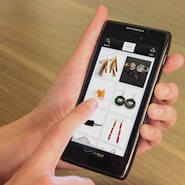For the first time, online sales on the iPhone – which have been growing steadily – caught up with purchases completed on the iPad during the first quarter of 2016, according to new data from Bizrate Insights.
The iPad was once the primary driver, by and far, for mcommerce sales, but its share of sales has been declining for several years. At the same time, the volume of sales taking place on an iPhone has been growing, resulting in each device posting a 36 percent share of online sales made on a mobile device in the first quarter.
"Once the lion’s share of online purchases on mobile, tablets are still declining as a percentage of online sales; meanwhile smartphones continue capturing a larger piece of the pie,” said Hayley Silver, vice president at Bizrate Insights, a division of Connexity.
IPad loses ground
Bizrate also found that Android accounted for 28 percent of mcommerce sales during the first quarter.
Overall, mobile sales as a percentage of online sales continue to grow, but desktop still accounts for a significant majority.
The iPad has been losing ground in mcommerce sales as interest in the device has waned.

The Body Shop UK's in-app loyalty program
The findings point to how consumers are becoming increasingly comfortable purchasing on smartphones.
The results suggest that retailers are doing a better job at uncovering the best tactics for driving conversions on smaller smartphone screens.
Pulling out all stops
Retailers continue to pull out all the stops to enhance the shopping experience on smartphones, recognizing that this is where consumers are spending much of their time these days.
A number of trends are supporting higher smartphone sales.
For example, the options for placing an order – for food or hard goods – on mobile and then picking up the purchase at the store are accelerating quickly.

Staples' app users can add available rewards items to their mobile shopping carts
Retailers are also taking better advantage of data mining capabilities to deliver personalized offers to smartphone users.
A bigger focus on loyalty is also driving mobile sales.
The Body Shop UK recently said it is integrating its loyalty program into its shopping application, enabling users to view and spend rewards points (see story).
Better applications
A number of big retailers have unveiled significant application updates designed to drive sales.
Staples is fueling mobile sales by updating its application to include sneak peeks of weekly advertisements and push notifications to alert users when loyalty rewards become available (see story).
Retailers are also streamlining the checkout experiencer to make it easier for shoppers to complete a purchase, for example, by integrating mobile payments.
While a number of retailers have integrated Apple Pay, Visa Checkout and other payments solutions with the goal of enhancing online sales, some are going a step further.
Supermarket chain Tesco recently rolled out its own branded mobile payments application while Walmart launched payments inside its app earlier this year.
Retailers also continue to improve mobile merchandising.
British retailer Missguided is focusing on a Tinder-like swiping experience for its new mcommerce application, a strategy that could become more popular as the image-focused feature fits well for younger shoppers (see story).
Sephora is bringing live 3D facial recognition to the existing Virtual Artist feature on its application and Web site, enabling users to view themselves moving in real time with the digital makeup (see story).
Beyond online sales, Bizrate Insight’s data also underscores mobile’s role in omni-channel shopping, with 21 percent using mobile devices to assist their in-store experience.
"But retailers beware – almost two-thirds of mobile shoppers use their devices while in your store to look for discounts and better prices at competitors,” Ms. Silver said.
"Furthermore, 58 percent compare your in-store prices and coupons with your online prices and coupons – so be consistent,” she said.
{"ct":"9MXUF4zdjyThq6XnG0TPLITVHUf9uD2UV5bVy6wIpmyUTXbREat4pPWwXpDzncc8NoVuxodfxt2WSA54lwp31EQNfHkxTNRfp\/hEFj3ggX39bJFzdgUrA60Ii5ys5ICzGd+vy78liEYrKNRY+AzG+0cJerF7x5vedK2yv27Wny6lfAXxZmLsTCQAyJTbdO+reYTG2d4E+517PnHfjqRiEq3ezjB3OyKC20hpIlZu7eOPBqGAHVjzkkSkcFDPhwPcx+sExRzNeEZT1UgI63XAPLuEdj1UyQ1rB9Fu\/szyjbTmY8mq3+uANYe31pQdfqsiY\/zFlEqDyOhcg0ZYIP52WTiwdKBZ7eBdXTEM2V7sJ11RG5VQzvxgJiEsOwftIQk1JfFfcMkU9hutPyLyrTVI0W6gVpAPQ5qK3cH+\/xPicXyCVEcfBhJRGlRrXJ1cR4fuB\/T+GmrycV+LrEXyUuzjUqDjMbR8GfUsMm0G28d0xb5BD8qeiQ9kwNB44ixZoLfYBmOTBYIlgb3qGbblfGQwsTP\/r5Eq4XR5XV+KUTIx\/fXLByWkyJLQhSNmf0d5S2wfYy1DY4ByBkOJwF3julNls98WEO3jO+MYw+X5sHMeoFLULKrwBTzmhFXfKehsj1TNWGWbhkFTHCzUA8ngk5w2NoPkhLSuLKxyAAE5CI\/dbaGWBPmZEA5vKx4fcNgLBWVGSyVRsjnZbrl0Qq8JD0SfBdZQQvHYExbfWHLiy5GGLk2QpqnAz9xzNWrc7w4mZCUbMOuysN5w3dgkp\/p+lG4r68p8SPvKjXc1JCl7WpMK+H5R+x6HVFhFfOaFbJGqH7Rp\/3dOENErktfEW9GA98wkGjEmjv+rIsKOxujU+nw9C9ZECNYBM6rFL0kG5HkoxTVX1Zq6CZwMQ2SHy62WBY59tBroatb2OHnNzUEcvCRvSPmT0iwwqLCveRiglG2+vahisjZbF+KSsPc4ew2RcMZOMbCvuuiniAgtUR8ciF+cs69WwtHsHvTQ5IwyJeOPcxAVk9uBzaFAKvweV6XuD9kHyPf6Lvb\/zdjHEKmMVHBWHdHHKQJ9FrA8\/epauU4YwuwfWiGk9YNBEsAGzp+YM2uaTb8UrL8VHaHSrFBU11WdAyI6fHo9oUSF8Y4S3xvmpham8GcsV3lQR\/xc1vltNr+GqlIkYJDpWbnj7yk0MvkOs8Y4C7ESEaFLhNEP8Hq7eHVmet4KYGeQ+TPLiyPhyVeGL8TIV7TzDI9lWJuAw2YOGC3Q8l+Qmg9\/7XpVSIKZKOAq4UeQllzSP+EULe0VIJMUUj9KkVFK\/HQTXN3j6Ipfy8Lg5mPyk+iOcoNenKFvncpjl1YQScYlF+RZnZ9OVz38eBjDBs7BVOzQiKQGALw7Viyqhv\/jYeaAFD2hnXrYPtMkaz8rt8pMos1\/ocaYCDsp+EY+tEsTGp\/tMQDZ5Dzhu50ImG1HBpEFNpetlVcEIh1Lk3gaKHgv86XoBrxwjvkzsWvTW9tyo1WVpxJm8dXqo5UX7ZJSG5T2PLeF1sz251gBl9ug24zjEOsF963ugV\/9M7Tzx1LOWczgkaBLl5HAugYw8nMbCNcW0VTUPVJ01pU\/3QMyjvFFEpd61EC1bcCcrPf+c9RV6way8KttlO5FQqGNG+FfD5WrSlPhOFs8kQeNTNOX21K046+nhtkCOj+Wrbw+cPyoF95dKiaR9TtbdC9d7rxgtbqCEMxGSNKBgKq4Gr6oJ6woPOeBFYNM9PYGbZslQqQ1co3GyzGOTkuM1dY1Nk6tkjPLXHgSF+djk8f22fT4SBClHuCkHOq\/7H9nOjkBvc7AVLZFmYDmyB8izzpamcrxa0sTLk8oU19TxukwqJMC+LBMriH7vUAGJNjStrWDE1KxzTjkrWoftwa2vNym9E4dlKinU3XJck8tTNA58enQAb\/v72VNsXJ\/XeDudU0Lpt1xaXL39\/qTDMzciiKWF7VAaQJFhiBsfjBZko2lUagJDkRX3hiyaDmWQA5WR3zNU0KsFIZKd9Mq0utnq1IpWWlwliaKsIz21+c5jDqrw3BPYBalj\/++R\/BESLlSF0u6bWNemIelgbLyZLyG0v9pmoP5ozAa9KhanMZZB9H\/pio10aZxFcspqF01SxTXCMWa\/gvNDapBhPKesZ1uKWM7YQtyou0ENZFjRYHnAVS0HrYFskY0FC6p7+4hW7hvP62+625R9KZEJ9nY9eTwoX1a3lTlGWEaotlLwPwpdspyPvcg5WE8O9lo8nxRbWr+k5eTYGV1IT5auHv+by87gsEYNiCDszqsJUdtindZcvYb0btRzS405U92paQW\/bvnBExPqSL8qHksCNq280VV9fktUwiFUICVCtsydZjGEu3ievvj2tr0RZNup\/\/uv\/bLWxX89dKC85pKLnOilQwCEmxDcRn+5PTIxCdhuCzIz9VSBrQWsh9vFXarnzq9+SNqsKLU4jk\/Vh1dt+SzojvrxYQzpFOp0VZwQcsIJenEArwoc1TTxmTy07Uhdah1u3qeSyebNwxqzhesDEOpHloKsQE2OXY0UL66DTO5pPMRxK6trEiVGnaF67p3ww+5ngqJUUyj8dVzTQ5jy\/MJ8gdhIg2S+RxTeh2gLiTvoQRK9ziR3xJAtY1HXOMX+LauYDbC6HKwqSM0RkWm1CNw8TGroXOlEsiyVQ75dSEMKdN7EgxQg4AqTo4CrdP5btE5\/25JRgQYSHPQExsh+91lM4nddHilfgSxVqlan4zybgFhE2pI\/tocyiNvmvnN8DVW6Que4x61Hh42Pfp5bC7pMEgNM+7xCbtA+Wf4uSfR+h4eQXvLYvbf+Dmm8QQo500hhz0Il7vUaooB96H5pyUK6Vy0r7hIvv3wfcF9oGcmeWg6MzCMutk9zeQgFriBW2FroBMUhjOT9z4LtRC7eg+w6ip90cI5HnCpsJbLeKgArw8dWb0Mi7dhtUu3nXyKFPB2L8YkJfWjC82IW87TH69Cn7wU5IIvvXE6o8C+2vQoMqIwOQzVmV7FWAoxu4Phmx54ap2Xd0aBMEkzbP5hIMmSvskSqrFz0P2K3fhCBmdOw1HkyDicFfkbajDGLOiSX9LtydeEsd0TujohlJRLHob0\/9oq6sZcDy8TxDHDuxXSSIz+JafFO8KvXYVw5\/e33NiNlLtnbqXspn6tIZAWNhlEaziOSxX13vs5wdiajJhl4AnnUrga8PAxkiCmsHuqfOPacLe9xce7HvRBz8D63rAC74GI+u+6kMFWZQ\/tK4mvyOmA03DCCwiPXs7cGOos0EXia0FbIO7+1ENjf8pJEJSdr6keUaOrwwMTus\/9Z0\/CkBfEv8w8cIcfaB43E\/zezPdPh\/ha11XvtPQkjucKy0AJvdZ4pIqB3ruELCP9gfqVj\/IkFlBasj9M\/i6MYVDubbsEXXh6sXtVKhLj2lF6JXpj+iq+YRGGxAA62ecu7ha7lIOYkKUf4\/0IkfqcdRLvAZGT0n3YWMr+bSBvwuvbpgnZAXeC8cwZ8Wxk0TbUbhRHOwzdBewa+WqyiJmWyRa1c\/JqMpC7WX+r8qQXFD2J8u8Vd+OHV88N0YJ8nXriMlolVBSZERlON6uxx7SDhPem6DLgxTlpMWYHwQFBQxSu6bt+Ic5RJO8w4kNRggbV\/iMLNymRxa3hjwy267516kl0yOrNoQP2DaulTLEmcleXzE0CnwpxrVefo+9MVt7Cb1B9bj7Nd4fKTNzLvkAZfcbnewkOoPn0V3NVWE+EQhgszscHbvcB9q9987thBcNUPlYcw+MNweTUtRO3pX5FUlVhZiZOIRmFd4OI9pClieeVPd3LK6cWE\/qTBiG1nrcSZFVGfRGW3SAemN4GMl3fyhFSqTqv2Jne4DxPeMsnRKU60JWG81SiDDC7h7W7H9DiYhVkl6rdvcbcjDnuWoapodFO2E+TViLFpctfW\/AxtyH5rXVBWBuslt4A6u0LX0\/hImxCVM2ctu3uMNjoEyul5RO0G06rn5AHTOO\/2EFs8szJpVfrXjsKjlKybhKqqIFORO5LXSBSxLw\/1WOE\/OQ\/U3Ve5ZURiSuWz7ZDVB\/jcR5fD1aBnu8lBVHinmrnd90m5ljBXwVPxZxcBb3d+xgrCy6+lsGy7qB6QDGjtDRPOioG9Q2voCSgtxBdlNIx43loqOxKqQy9UAh8JILhI0e8H\/lbRwc1VrBgyQmQDMvgOvNbeZ6NItaM+Y\/nhKbvujHsxReevFM0CRvgGXGwA74Nc0SZafm6rywK45R3xJmX1q+mfaaicwbvG2skQbMKvTqhaXqqafCMaDLRQGPc0J8ue0UsaNo4jH1NpEGpehU\/zCHcDw9BW7n5CoGHuSnNhFCHkbM4ql0j7gLqpDznDw5gAXjst9nQLzrhRsikuXuWSUbh6taep5Ca2EdD\/p1mto1eFj\/mUwjh4hAVkQql1RLnkijpMduy9c9o7AdGWCYxsrZNDv36\/kS3v3A2QB4r40KqCmhoyUeak39WzfCGxzUV9YMKPtm1uZGlT3y5lC16t5Sgy5q5tnauJjJypPopfKjDz8cXKcE9+b7XH6QB4\/I4thmaBTY6nl11G0WDL5AFzWGJRZG+DHFfbSm9wI6gDeDe8y+5HEsWNj\/h2Wt\/uLylWGaBUHE2RjwmD2PM6xw2w4JFxSzuE6FhbgjKDbpfuyM56ne71Pk1TG\/wON7cjETBa6z980dTg85XiJiLWdvUULbdyo64yki7GgD7h2GNwaY+yrXMlqXE+l5mqhp4uAjaWZmf3RoiSAOR6OCUoyuNs0YZRkEPMz8DrNHL8r\/j5OkXqXllHdUZN8sbpGr6L+TmB4Tr2B\/6C6K3brVAZsh5zRB4BkwlJuDYrsHgQtl1J1VqLlhznGO1xD2M9o\/Xd74V5YtS1Vtrpj+M9EsDHMYk3Ssec83yPXgvPo6G7fCoOc2+Q5CyZvRuZAH8opkQ6vuw6xqDbBVRiVj1YgoaEQuM6PxyM18R971fcG8SzMJ8t20G7fS0cbsTDzw5pj2SOUDRnwfDEnnhc8mJy53VCga1amSQIDq3F5UEbxs5m0LVo7gwk7Bwbj\/RRbIq1u0LO9jZ51jw0hTIoGFFsWARaOXGT6R+w0QF0qU79xTLRoND4yL+E80812ZSkRTEvIrw4QoAtx2h3bno2Ou30GNA6ALOG6EPAlH+peIzglvVvqteVX8TTydxODPvH4Tm1Q6SQSW0zYs0wiP+qlrkRBjUC4nn7xFTtZYrw1btaMdNxKd1evNHCL+uM2qimXDba2G83WtuyBDIKSWK2\/oW+jiJJOnxFby\/ZSgCG3iDxCgz82nQn4t7Xxe7Zedwin85qVq6sXN9Nyyo41ScCywZqiSKxrqXxih64GpL0xM0rVE9IR3vWoOJomoBKGYQEqOVvY41tJAXNae4SBaMe6iQnwhBSkL34vy2Y7FnihKHZmkrOskzonZPxiB927ERKF6GfU9CcuvlQMRdgxCk9QSYs48sy4Aa9yZzev3hWhD+GnaDncce\/hgD4FGfQ4BCiwfUJ9MQPwnqwJcF008fHQeXNWLrB\/lO4+6pTvhD\/qnEMUtN8YYEIrt1MjFFOatVP7nygd3jU7fnpMPAmdJet3qHxX20mixfdJ\/D7ZQxwG0AAQ0L7MVoMyEoibSMeZWfq7UJrhptr+Tq48WxPSdDN4BohSjry+uLCh0PiBkWIeLuMV3LmIiwuXIk+Pu8Z3Hlw\/XgUSgWTkAivD4hOckba3eJYTxOY0Ary47KpcpK5cUhkwgOpazPGtkoGVFQaGmhoE8ZjQgIkbC+FusSdERRNqaKfSuOQMPt7Td2HH0mv24lwZzqFOD2cbcCQ5GXoF42FcHTfmQUuuyIkkFrF5qR\/ax5uXaviwAdRF2I4yptE60Bm1rNkswAJIJ1Ma+zel7gFor3lVXtvpj4d5hi9HqaoY4B0GJ38e1w8rf5nsXAXhrdwtBWFT8KDXNsryxCQfyc244yOkvy\/XnLxummWXRLGVL9npDZ038Qg6eWc+Fjmo57qNApHl7aEetV4s2frkiafNDoTwKaJtWm9kqwj6r91OamOoeR\/HPiaH8ivIw3KOBOscpwfLQ9nRsYB2kJn\/IkEQTmCCvVVNYyI3NKgYLGlBpWrqfbJMeiOL0CyzHtLF8s6V6Jk0aY3OzJ7wWAJAUAbNRbPUpQ8B5Iw3YShxkuKdUpl7CwJ5WzvXNtbWQCEaIus0OGEy4kX6YM9rm2dzplCuQR\/6Ht+rXi6HHZ8D+2LNRRSO1Do4prtuchEyx9prjjMFhdbnX09U1xCxLZ0uVhfbnK+Fb0qdjyCN7UWv\/ox7a3Y35kHb3XWPbtv4PDDlCpGMudMHrQK6bDax5dAYIoSubtidwtwbdBI1e8pDL4vpN3O5B7\/M9PANalvqlwBsM\/DHmjmKoCOY4n1y2oN3TxLMPMel3QWVwq4TjfxR2oIc468978D9rsQLGmHR90j833pzJL+3F2J356IkYuX10Xgwo4PkAhIl+Hs2BaMasItoWiXdkY72MzsVDxx+mY6Xmyu\/t3MFEvl2acpckZARY4pyCPgQjO9lPxml9E8o+fAAjPIFwfPQjMfZsilZp7S7JgTec2MOqFFtgq9w58UIwPVVb1YxqSthuAnpXEOii\/mDyMsRPxFSI8+pj6YQGGvQp6rwryFnC5E6T3O2qQht\/ZqOQoYZoLq5rstN\/ehDJPhxMPZ\/F1XJzR\/OQ20vS1Ur65R\/w4CRc7G5iV\/96lU9uq9x9+xObkcTkUWNIFyvRy1bQyjyNBA9utG1H9Cg1GG1xEuatQl9AXpW5NgftgammrGanlPaCd0uXr0vYmimD9pVy6WYDQfBLAZ1jmYVd13CJqLxV8\/GobgbHTDPm7ThsGkNvQ4LRh8xkbQGo0dUP9TaC8lAXMJg6JoByBHXt3Ci7SX9wN3jp5wa2BuNIx1pHafsmvJeYV3rIqjNufiL2vuSrCtfUp4Hwi1PQQDnlI9ylfU8+07f6XvZA62yhniDw9EZwJkGP1M3TPPC80\/mVQ9y7RzP1tXRBHiNXOFFqvznsTb13z12NVBKZCENy15eufDzQJ6zKGXfVzGcEUXDGPmBoJVDSaGBflGJDBeyZE9WE1xZSid7o0hhYkOyAdbLiAUdHzhsEcK9hn+qWssszxoJI06Tf2pRjRkgpBl8dubNoEz7\/MxTn5EYl1mfWVcV3dgi77xh38TomRLHWuOdyBbiVjoXtcWNBmcN5nt4ZUG3SDU1aTMRl8WxUZ6nVRDY6TmXCJ1j\/ZQvOB02vq2G5P1Lo1gomJx4W\/i3ofZU\/0DGusblU0xX2NiK2tsunpBi7xHKb+6iBMygMKGWvNls0ygkIPVtRKNxyLbtuVdlDjxvAUUiNifZpQ+z+92cQPwAYxzVOEGrdpQcqizFWiDP+hTPP\/iAQ1zmwEGVS3w9RzbXNuxgUwk5UvGKhz+QtAdTNOdKi2XDF3rAF0ipxy5b\/gGQ8vggTGKsdtI5UFkpVYFkodVGF\/IYfuEbosEpV\/R5LrwAsKpApPwDX1q32H2pkRlDwUjyTJxtHvDycqd36p3HmhQD5BVfA9nRvHYAIuXAGhZgbXlS52Mi9pRRGJRRnidGF4NZ2vvK1nuAW+Qlog60tKZfF9Q3clQcWxLxWia9wXMMqJzAjSy\/EAWC1RCZQhe4jgK2Y06ygL5ApPPXsXedwKRfsBkBiUv8saNOb+C221JWDd3HkKwYpjjpYJ9JlbGJjRoyqa2MJEFCBOQUFerjQuuFw=","iv":"9ff095e9a5b6faf457cbadf3a0d3ece6","s":"c11a109cb9adfabb"}

 Mobile transactions continue to grow
Mobile transactions continue to grow